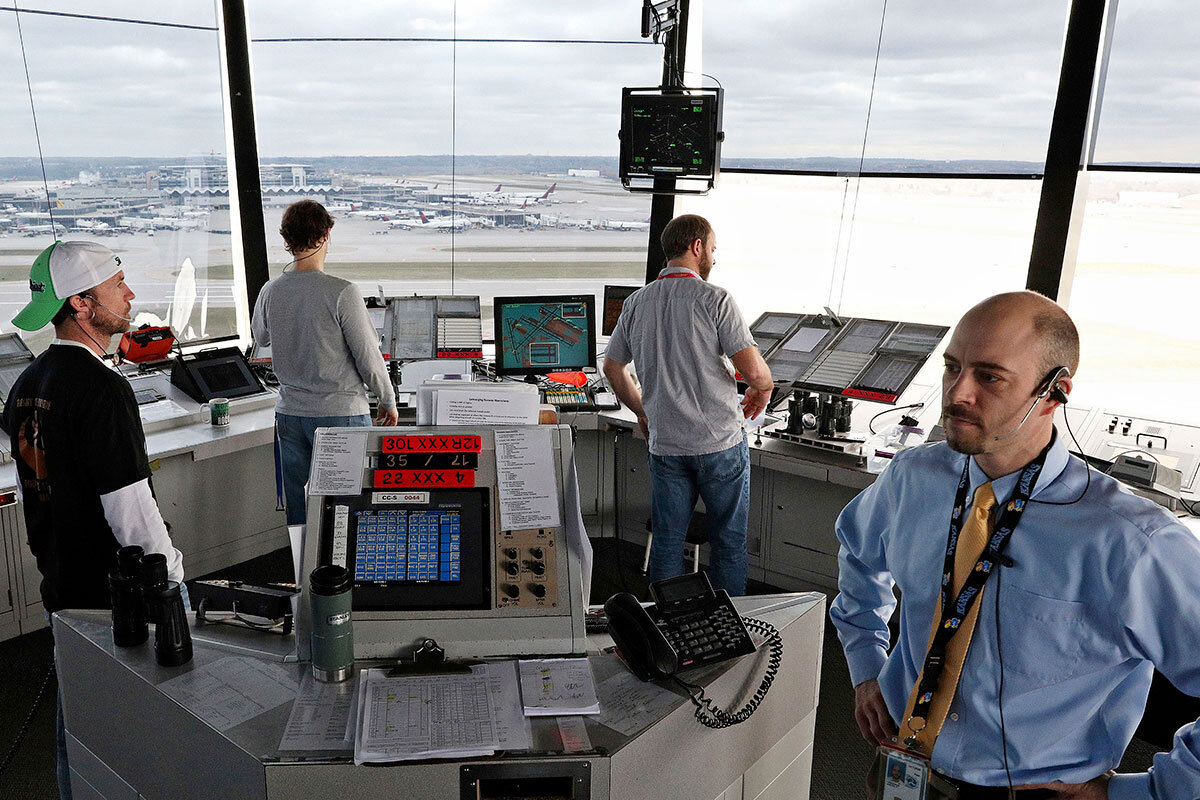Trump’s touchy question: Would private sector be better at air traffic control?
Loading...
In pushing a plan to privatize America’s air traffic control system, President Trump is reviving an idea that’s bounced around Washington for 40 years.
At least since 1974, Democratic and Republican presidents, conservative think tanks and labor unions have put forward at various times the idea that some kind of private entity would do a better job than the federal government in directing the nation’s airplane traffic.
Many nations have moved to a corporate model and have adopted modern equipment that has streamlined operations and cut costs.
Mr. Trump is hoping the United States is finally ready to follow suit. “If we adopt these changes, Americans can look forward to cheaper, faster, and safer travel – a future where 20 percent of a ticket price doesn’t go to the government,” the president said in unveiling an overview of his plan at the White House Monday.
The proposal highlights a culture divide between the federal government and the private sector, from which Trump hails and which many conservatives laud as more nimble and effective than government bureaucracy.
It’s not that government always fails or that private companies have an untarnished track record. Defenders of the Federal Aviation Administration laud its safety record and say privatization raises the worry that safety and security could take a back seat to cost control. But critics say the FAA has been faltering for years in its modernization efforts, and that the problem lies not just with bureaucrats but with budget fluctuations and a fickle Congress.
“In principle, it’s an excellent idea” to privatize air traffic control, says Peter Schuck, an emeritus professor at Yale Law School in New Haven, Conn., and author of “.” Much depends on how a privatized system is structured, he adds, but “I don’t see any reason why it wouldn’t work here.”
The US is widely regarded as having the safest and most complex air traffic control system in the world. The FAA, which both oversees and runs the system, handles an average of 50,000 flights a day and more than 800 million passengers a year – not to mention more than 3 million tons of air freight.
Smoother financing under private approach?
Yet the FAA remains woefully behind the curve technologically, in comparison with other developed nations. A 2009 research report from Suffolk University Law School in Boston found that privatized or corporatized air traffic systems in Australia, Canada, New Zealand, and the United Kingdom were able to reduce costs between 5 and 15 percent per airline flight over a seven-year period, while the FAA’s costs rose more than 20 percent over the same period.
Part of the reason is America’s political process. Although much of the FAA’s budget comes from user fees and taxes, Congress still must appropriate its budget every year. When a shutdown, or even a partial government shutdown looms, the agency has to curtail spending on long-term projects, delaying modernization projects and raising costs.
While GPS navigation has made inroads, many pilots in the US still rely in large part on a 1940s-era navigation system based on VHF radio signals. That system of short-range signals prompts airlines to fly waypoint to waypoint instead of directly to their destination, which is the more efficient route.
“At a time when every passenger has GPS technology in their pockets, our air traffic control system still runs on radar and ground-based radio systems,” the president said in his remarks Monday.
The FAA is supposed to move to GPS under its NextGen modernization program, but FAA efforts have been delayed repeatedly by annual congressional battles. In 1993, a performance review overseen by then-Vice President Al Gore, found the FAA was “constantly hamstrung by budget, personnel, and procurement restrictions.” A 2015 report from the Congressional Research Service concluded the same thing, the agency lacks a dedicated budget for long-term capital expenditures and can’t float bonds to fund such investments.
Proponents of privatization point to two key advantages: The corporations receive stable funding through various user fees and they can raise money in the capital markets to fund modernization.
Security concerns
Opponents argue, in part, that an entity guided largely by commercial interests may prioritize industry profits over safety and security.
Former Secret Service Director Mark Sullivan, on May 16, questioned for instance whether background checks for air traffic controllers might become less rigorous. He added that the FAA’s role has included securing airspace during high-profile events such as presidential inaugurations, political conventions, other national special security events, and whenever Air Force One traverses the country.
“Privatization of the air traffic control ... would pose a multitude of chain of command issues, differing priorities, and perspectives that could potentially elevate risk and interfere with the end goal of ensuring aviation security,” Mr. Sullivan wrote.
Although the Trump plan represents a sweeping change, outside analysts generally have not voiced deep concerns about safety. The FAA would still oversee the system, monitoring it for safety, they say.
For its part, the Trump administration has included security issues in its stated principles for privatization. Those principles call for a system with integration and cooperation aimed at ensuring “sustained national security and law enforcement capabilities” and interoperability with the military. And the principles say the system “must be secure, robust, and resilient” in the face of cyber threats.
A complicating factor for privatization is that the issues and the stakeholders range far beyond security interests.
Players competing for influence
One difference between the US and other nations is that the US has a large and politically influential contingent of private pilots and small aircraft owners, who have resisted the privatization plans put forward by Democratic and Republican presidents over the years. Their fears center around two threats: 1) that the corporation’s board would be dominated by large airlines and unions, which would ignore the needs of private pilots at smaller airports, and 2) that in the search for increased funding, the corporation would begin to impose fees on small planes just as the FAA currently does on large planes.
Local pilots have significant clout. When the FAA tried to trim back the 1,000-plus radio-navigation ground stations to save money, small-plane pilots and others came out in force to oppose the closings.
“It was really just painful,” recalls Frank Frisbie, a retired senior FAA executive who now runs an air traffic management consulting firm. “Every one of these [stations] we tried to shut down had a local constituency.” Pilots didn’t want to change their equipment; farmers found the FAA’s weather broadcasts useful, he says. “And every one of them has a congressman.”
The administration’s proposal builds on an FAA-privatization bill introduced last year by US Rep. Bill Shuster (R) of Pennsylvania. Unlike previous privatization bills, his bill at least got out of committee. It’s not clear, however, how much of Congress is ready to enact Trump’s sweeping reorganization.
“Congress ultimately has authority over this system,” says Mr. Schuck. “The question is to what extent it’s going to relinquish that power in favor of a less politicized, more flexible, more forward-looking governance structure.”
Much may depend on the details of that structure, especially how the proposed entity’s executive board is structured. Rather than guaranteeing slots to representatives from various aviation interest groups, the Trump plan would have the Transportation secretary pick the initial board’s members from the nominating lists of five groups.
One potential hang-up: General aviation (the private pilots) and airport lists would provide only one member each, while the airlines, unions, and Transportation Department’s lists would provide two each. That eight-member board would then select five additional board members.
How unions workers fare
As in many other nations, the corporation would be nonprofit, funded by user fees, and free to sell bonds for capital improvements. Existing union workers would lose their federal status but would “have similar rights to those they had as federal employees at the FAA.” Left unsaid is what kind of pay and benefits new hires would get. With such concerns pending, the air controllers union has given its provisional backing for the thrust of Trump’s plan. Like FAA controllers, the new employees would not be allowed to strike.
If Congress does pursue privatization, the change won’t be quick. “You can't just snap your fingers and pass a regulation that makes the system modernized,” says Mr. Frisbie, the consultant.
The administration envisions a three-year transition.
Staff writer Mark Trumbull contributed to this report from Washington.





